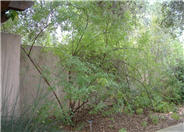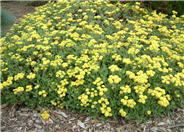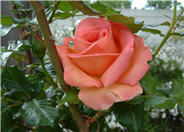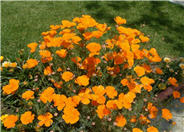
Common name:Cedros Island Verbena
Botanical name:Verbena lilacina 'De La Mina'
Verbena lilacina 'De La Mina' is a selection introduced by the Santa Barbara Botanical Garden. It follows the same wonderful characteristics described under the general species V. lilacina.

Common name:Blue Elderberry
Botanical name:Sambucus mexicana
The blue elderberry is a deciduous shrub that grows 4-10 ft. tall or tree that reaches up to 40 ft. high. The leaves of this plant have 5-9 leaflets with white spring flower clusters developing into blue berries. The blue elderberry is a native to California, is drought tolerant and is a beneficial insect plant.
-Cornflower Farms

Common name:Sulfur Flower
Botanical name:Eriogonum umbellatum
This plant is a low woody perennial growing 1-2 ft. high with 3-4 spread, having dark green foliage and attractive yellow summer flowers. It is a California native that is drought tolerant. It attracts butterflies and beneficial insects. - Cornflower Farms

Common name:Hybrid Tea Rose (selections)
Botanical name:Rosa Hybrid Tea varieties
These shrubs and vines are the most-loved in the West and are very resilient. They come in a wide variety of sizes and colors and are easy to maintain with proper care. They can be used in a water-conserving garden with careful attention to irrigation practices.

Common name:California Poppy, Golden Poppy
Botanical name:Eschscholzia californica
This small annual (sometimes acts as a perennial) plant will grow to less than 1' tall and has light, small blue/green leaves with gold and orange flowers that bloom in spring and summer.

Common name:Deer Grass
Botanical name:Muhlenbergia rigens
The deer grass is a warm season perennial that forms dense clumps from the base. The spike like flower stalks grow 2-3 ft. tall and this grass has striking foundation form. The deer grass is native to California, is drought tolerant, and is a beneficial insect plant. -Cornflower Farms
| Designer: Stephanie Morris | Fence and Flower Explosion |
Photographer: GardenSoft |
Soils and Compost:
Physical weed control, including mulching, or hand removal protects the watershed from harmful chemicals.
Water Saving Tip:
Apply a 2-3 inch layer of mulch in planting beds to conserve water, suppress weeds, and protect the soil from compaction and erosion.
Integrated Pest Management:
Develop healthy soil for plants that are vigorous and naturally pest-resistant.

